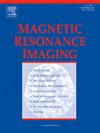利用 Gd-EOB-DTPA 进行肝脏磁共振成像的肝胆相位图像评估方法的特点。
IF 2.1
4区 医学
Q2 RADIOLOGY, NUCLEAR MEDICINE & MEDICAL IMAGING
引用次数: 0
摘要
目的:本研究旨在表征定量肝脾对比(Q-LSC)和肝细胞摄取指数(HUI)在肝脏磁共振成像中用于评估肝胆期(HBP)图像的钆-乙氧基苄基-二乙烯三胺五乙酸(Gd-EOB-DTPA),并确定这两种测量方法获得的结果的差异。方法:采用3.0 T MR系统对连续29例随机抽取的患者进行评估。对肝实质和脾脏设置3个感兴趣区域(ROI),取信号强度(SI)平均值。计算Q-LSC(肝脏SI /脾脏SI)和HUI [(Q-LSC-1) × 肝脏体积]。计算全肝、全脾、左外侧节段(LLS)及其他节段的体积和平均SI。随后,比较Q-LSC (R-LSC和V-LSC)和HUI (R-HUI和V-HUI)基于roi和基于体积的值,以及整个和每个区段的值。结果:R-LSC和V-LSC在全节段及各节段间无显著差异。相反,除了R-HUI和V-HUI外,所有的HUI组合都有显著差异(P )结论:Q-LSC和HUI可以通过Gd-EOB-DTPA成像评价HBP来表征。R-LSC与全肝R-HUI或V-HUI相关性强,但LLS影响数据,而HUI取决于肝脏体积。R-LSC是简单和易于使用的部分图像评估。本文章由计算机程序翻译,如有差异,请以英文原文为准。
Characterization of the evaluation method for hepatobiliary phase image by liver magnetic resonance imaging using Gd–EOB–DTPA
Purpose
This study aimed to characterize quantitative liver–spleen contrast (Q-LSC) and hepatocellular uptake index (HUI) for evaluating hepatobiliary phase (HBP) images using gadolinium–ethoxybenzyl–diethylenetriamine pentaacetic acid (Gd–EOB–DTPA) in liver magnetic resonance imaging and to identify differences in the results obtain from these two measurement methods.
Methods
Twenty-nine consecutive randomly selected patients were assessed using the 3.0 T MR system. Three regions of interest (ROI) were set for the liver parenchyma and spleen, and signal intensity (SI) was averaged. Q-LSC (SI of the liver divided by the SI of the spleen) and HUI [(Q-LSC-1) × liver volume] were calculated. Moreover, the volume and mean SI of the whole liver and spleen, left lateral segment (LLS), and the other segments were calculated. Subsequently, ROI-based and volume-based values for Q-LSC (R-LSC and V-LSC) and HUI (R-HUI and V-HUI), and the whole and each segment were compared.
Results
R-LSC and V-LSC for the whole and each segment were not significantly different. Conversely, all combinations of HUI, except between R-HUI and V-HUI were significantly different (P < 0.01), for the whole liver. Correlations between R-LSC, R-HUI, and volume-based LLS were lower than the others.
Conclusion
Q-LSC and HUI were characterized through an imaging evaluation of HBP with Gd–EOB–DTPA. R-LSC and R-HUI, or V-HUI, of the whole liver were strongly correlated, but the LLS affected the data, and HUI depends on liver volume. R-LSC is simple and easy to use for HBP evaluation.
求助全文
通过发布文献求助,成功后即可免费获取论文全文。
去求助
来源期刊

Magnetic resonance imaging
医学-核医学
CiteScore
4.70
自引率
4.00%
发文量
194
审稿时长
83 days
期刊介绍:
Magnetic Resonance Imaging (MRI) is the first international multidisciplinary journal encompassing physical, life, and clinical science investigations as they relate to the development and use of magnetic resonance imaging. MRI is dedicated to both basic research, technological innovation and applications, providing a single forum for communication among radiologists, physicists, chemists, biochemists, biologists, engineers, internists, pathologists, physiologists, computer scientists, and mathematicians.
 求助内容:
求助内容: 应助结果提醒方式:
应助结果提醒方式:


